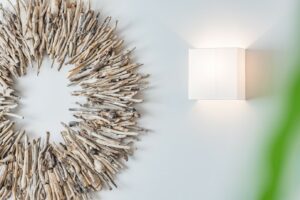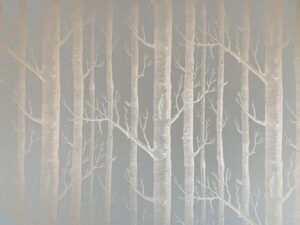
Can our physical environment really make us feel better?
People often refer to locations or spaces as their “happy place”. Places can hold special memories and certain surroundings can make us feel good, even if we’re not entirely sure why. In fact, there is a lot more to the connection between physical environment and wellbeing than you might expect.
Our physical environment has a significant impact on our mood. It is increasingly accepted that wellbeing can be improved by incorporating nature in our direct environment where possible. Where it was not possible to have a building surrounded by woods, water, meadows etc. then bringing elements of nature inside is the next best thing.
Over the last few decades, more attention has been paid to how health and wellbeing could be improved in homes, the workplace and care settings. Following the principles of design for wellbeing can help us to feel more open, optimistic and resilient.
When we became funeral directors, we wanted to create spaces which would promote wellbeing and resilience, and which would be welcoming and comforting. We are also very mindful that using some of the principles of design for wellbeing might be helpful for people who have been bereaved, or face other challenges in their lives.
Here is a brief guide to some of the key principles of design for wellbeing and how to create a sense of connection for yourself at home and work.
Biophilia
I recently read an excellent book entitled “Biophilia: You + Nature + Home” by Sally Coulthard [1]. What this book has taught me is that we were instinctively applying the principles of biophilia at Full Circle. Imagine my delight when we found out that our belief in the importance of creating a beautiful space, inspired by nature, has a scientific foundation.
The term Biophilia was first used in 1960s by Erich Fromm. He used it to articulate the idea that humans have an innate affinity with living things and natural surroundings. Since then, this principle has been embraced by many schools of thought within psychiatry, architecture and neuroscience. It is widely accepted that there is a direct link between contact with nature and our wellbeing.
Nature makes us feel good. What I learnt from Sally Coulthard is that science has actually shown that spending time in nature reduces stress levels, reduces anxiety and depression [2] and that nature can help us heal. Patients who can look out over green spaces have quicker recoveries and need less painkillers [3]!
There are many ways that we can create nature inspired spaces and harness the positive effects that this can have on our health and wellbeing. You might want to bring some nature into you home, work or community spaces – small changes can have a meaningful impact.

Materials
“Natural” means something which is as close to its natural form as possible. Pebbles and plants are easy examples, but it also includes using wood is its most natural form, rather than painting it and altering it to the point that its natural origins can barely be seen.
Wood is an amazing material and several studies in different countries have shown that the presence of nature can have a stress-reducing effect [4]. Fresh flowers have also been shown to have a notable positive impact on wellbeing and mood and adding flowers to indoor spaces has been shown to reduce feelings of anxiety [5].
At Full Circle we have wooden floors, use natural pine furniture as much as possible and we use tactile displays of driftwood, pinecones, chestnuts, dried flowers, and wall wreaths made from all kinds of natural products. Our blinds and rugs are natural tones and made from natural materials such as linen and cotton. Some of this can be included in any space and even small changes can have a meaningful impact on the sense of nature, and on how we feel.

Patterns
There is so much choice if we want to include natural patterns and textures inside. For example, at Full Circle we have wallpaper with large birch trees, smaller circular trees and smaller twigs with leaves and small buds, all in repeating patterns. You can find an abundance of flowers, animals, foliage, and shell patterns in all the elements required to decorate an indoor space. When you are next choosing a lampshade, rug, blanket or even a notebook – choosing a pattern inspired by nature could have a small but meaningful positive impact on connection with nature.

Colours
The colours that we choose for our indoor spaces can also be inspired by nature. There is no clear evidence about which colour has the most positive impact on mood, concentration, and wellbeing – the general consensus seems to be that it is complicated and varies with age, life experience and many other factors.
However, choosing colours which are common in the sky, sea, in plants and in the earth seem intuitively like a good place to start. Blues, greens, greys, browns and a tendency towards softer tints (rather than bright and vivid) are more likely to simulate our experience of being in nature.

Plants
Spending time in places which are full of plants can be very positive. In a recent study, residents with paved front gardens were given two planters with ornamental plants and Over a period of one year, we found that having plants in previously bare front gardens resulted in a 6% drop in residents’ perceived stress levels [6]. The number of people of people with healthy Cortisol (stress hormone) levels also increased from 24 – 53% over the course of the study.
This support the results of similar studies. So, if you would like to look after yourself, promote better wellbeing for yourself and your family – maybe this is one positive step to consider.

Small steps, big impacts
I would highly recommend reading “Biophilia: You + Nature + Home” by Sally Coultard if any of this has resonated with you. She has many good suggestions and really emphasises that small changes can have a big impact.
We are more mindful of the importance of our mental and physical health and wellbeing than ever before so let us let natural light into our homes and workplaces, choose nature inspired patterns and buy that houseplant or small bunch of flowers!
To receive our newsletters and information about new blogs – please sign up here.
References:
[1] “Biophilia: You + Nature + Home” by Sally Coulthard
[2] Collaboration for Environmental Evidence. “The Importance Of Nature For Health: Is There A Specific Benefit Of Contact With Green Space?”
[3] Ilrich, R.S.. “View Through A Window May Influence Recovery From Surgery.” Science 224 (1984): 420-421
[4] Fell, David Robert. “Wood In The Human Environment: Restorative Properties Of Wood In The Built Indoor Environment.” PhD thesis, The University of British Columbia, 2010
[5] University of North Florida in partnership with the Society of American Florists. “The Impact of Flowers on Perceived Stress Among Women.”
[6] Lauriane Suyin Chalmin-Pui, “Green Front Gardens reduce physiological and psychological stress”.

